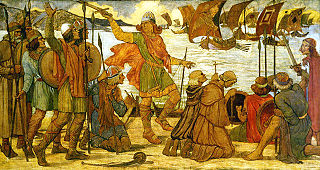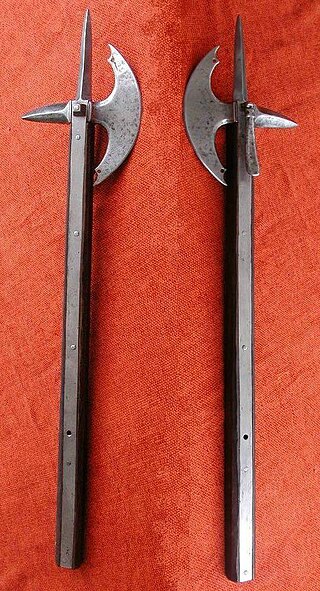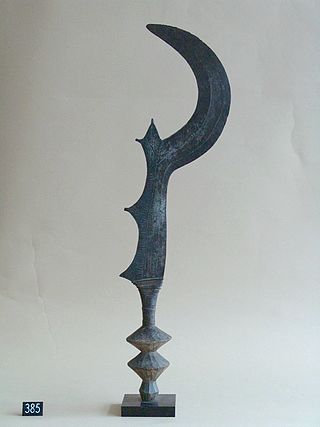
The Nzappa zap (also referred to as zappozap, nsapo, kilonda, kasuyu) is a traditional weapon from the Congo similar to an axe or hatchet.

The Nzappa zap (also referred to as zappozap, nsapo, kilonda, kasuyu) is a traditional weapon from the Congo similar to an axe or hatchet.
It has an ornate wrought-iron blade connected to a club-like wooden handle, often clad in copper, bronze or brass. [1] [2] [3]
Largely ceremonial, it can be used much like the American tomahawk, both thrown for short distances and as a melee weapon in hand-to-hand combat. It differs from the usual axe style, in that the blade mounts to looping prongs that affix to the shaft.
This weapon derives from the upper Congo region and was used as a brutal weapon in battle. It was usually crafted by the Nsapo people who thrived industrially from iron and copper. The axe is forged from Iron while the handle is made of wood covered in copper. This weapon yields a lot of damage when used mainly in close combat and sometimes directly thrown. [4] The Nzappa Zap has a club like handle that flares at the base and has a rounded head. The blade is also attached through a post extending from the handle. Nzappa Zaps sometimes has two or three human faces in the iron head. The axe is ceremonial and usually kept and carried by the chiefs of the Songye. The weapon holds power and significance among the people. [5] The axe was used in battle, as a status symbol, and also as a form of currency in trade. [6]
The weapon is the etymological base of the name "Zappo Zap", an infamous Songye tribal group once active in the Congo Free State.

A knife is a tool or weapon with a cutting edge or blade, usually attached to a handle or hilt. One of the earliest tools used by humanity, knives appeared at least 2.5 million years ago, as evidenced by the Oldowan tools. Originally made of wood, bone, and stone, over the centuries, in step with improvements in both metallurgy and manufacturing, knife blades have been made from copper, bronze, iron, steel, ceramic, and titanium. Most modern knives have either fixed or folding blades; blade patterns and styles vary by maker and country of origin.

A polearm or pole weapon is a close combat weapon in which the main fighting part of the weapon is fitted to the end of a long shaft, typically of wood, extending the user's effective range and striking power. Polearms are predominantly melee weapons, with a subclass of spear-like designs fit for thrusting and/or throwing. Because many polearms were adapted from agricultural implements or other fairly abundant tools, and contained relatively little metal, they were cheap to make and readily available. When belligerents in warfare had a poorer class who could not pay for dedicated military weapons, they would often appropriate tools as cheap weapons. The cost of training was comparatively low, since these conscripted farmers had spent most of their lives using these "weapons" in the fields. This made polearms the favoured weapon of peasant levies and peasant rebellions the world over.
A spear is a polearm consisting of a shaft, usually of wood, with a pointed head. The head may be simply the sharpened end of the shaft itself, as is the case with fire hardened spears, or it may be made of a more durable material fastened to the shaft, such as bone, flint, obsidian, copper, bronze, iron, or steel. The most common design for hunting and/or warfare, since ancient times has incorporated a metal spearhead shaped like a triangle, diamond, or leaf. The heads of fishing spears usually feature multiple sharp points, with or without barbs.

A mace is a blunt weapon, a type of club or virge that uses a heavy head on the end of a handle to deliver powerful strikes. A mace typically consists of a strong, heavy, wooden or metal shaft, often reinforced with metal, featuring a head made of stone, bone, copper, bronze, iron, or steel.

The kukri or khukuri is a type of knife or short sword with a distinct recurve in its blade that originated in the Indian subcontinent. It serves multiple purposes as a melee weapon and also as a regular cutting tool throughout most of South Asia. The kukri, khukri, and kukkri spellings are of Indian English origin.

A blade is the sharp, cutting portion of a tool, weapon, or machine, specifically designed to puncture, chop, slice, or scrape surfaces or materials. Blades are typically made from materials that are harder than those they are intended to cut. This includes early examples made from flaked stones like flint or obsidian, evolving through the ages into metal forms like copper, bronze, and iron, and culminating in modern versions made from steel or ceramics. Serving as one of humanity's oldest tools, blades continue to have wide-ranging applications, including in combat, cooking, and various other everyday and specialized tasks.

A tomahawk is a type of single-handed axe used by the many Indigenous peoples and nations of North America. It traditionally resembles a hatchet with a straight shaft. In pre-colonial times the head was made of stone, bone, or antler, and European settlers later introduced heads of iron and steel. The term came into the English language in the 17th century as an adaptation of the Powhatan word.

Knowledge about military technology of the Viking Age is based on relatively sparse archaeological finds, pictorial representations, and to some extent on the accounts in the Norse sagas and laws recorded in the 12th–14th centuries.

A battle axe is an axe specifically designed for combat. Battle axes were designed differently to utility axes, with blades more akin to cleavers than to wood axes. Many were suitable for use in one hand, while others were larger and were deployed two-handed.

A pickaxe, pick-axe, or pick is a generally T-shaped hand tool used for prying. Its head is typically metal, attached perpendicularly to a longer handle, traditionally made of wood, occasionally metal, and increasingly fiberglass.

The francisca was a throwing axe used as a weapon during the Early Middle Ages by the Franks, among whom it was a characteristic national weapon at the time of the Merovingians. It is known to have been used during the reign of Charlemagne (768–814). Although generally associated with the Franks, it was also used by other Germanic peoples of the period, including the Anglo-Saxons; several examples have been found in England.

A mambele is a form of hybrid knife/axe in central and southern Africa, originating from a curved throwing dagger used by the Mangbetu.

An axe is an implement that has been used for millennia to shape, split, and cut wood, to harvest timber, as a weapon, and as a ceremonial or heraldic symbol. The axe has many forms and specialised uses but generally consists of an axe head with a handle, also called a haft or a helve.

Listed here are the weapons of pencak silat. The most common are the machete, staff, kris, sickle, spear, and kerambit. Because Southeast Asian society was traditionally based around agriculture, many of these weapons were originally farming tools.

A throwing axe is a weapon used from Antiquity to the Middle Ages by foot soldiers and occasionally by mounted soldiers. Usually, they are thrown in an overhand motion in a manner that causes the axe to rotate as it travels through the air.

The Zappo Zaps were a group of Songye people from the eastern Kasaï region in what today is the Democratic Republic of the Congo. They acted as allies of the Congo Free State authorities, while trading in ivory, rubber and slaves. In 1899 they were sent out by the colonial administration to collect taxes. They massacred many villagers, causing an international outcry.

Native American weaponry was used by Native American warriors to hunt and to do battle with other Native American tribes and Europeans.

The tabar is a type of battle axe. The term tabar is used for axes originating from the Ottoman Empire, Persia, India and surrounding countries and cultures. As a loanword taken through Iranian Scythian, the word tabar is also used in most Slavic languages as the word for axe.

A Ngulu is an execution sword used by the Bantu peoples of the Congo Basin.